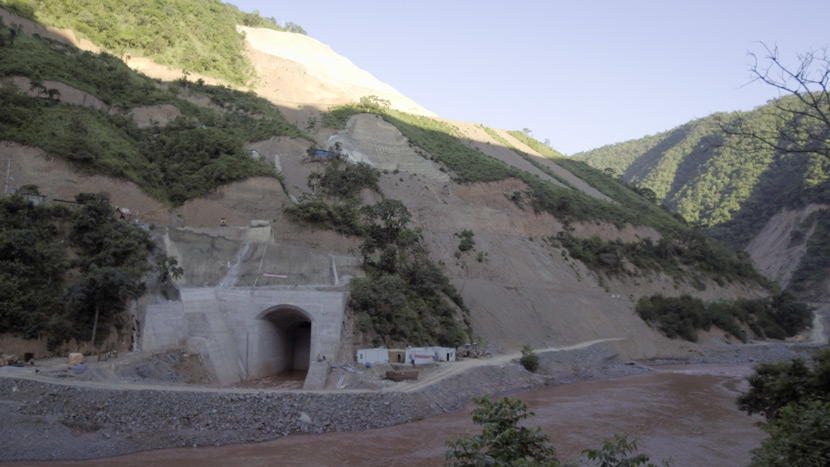
Despite coronavirus fears and strict quarantine China had witnessed a landmark victory in public-interest litigation on environmental matters. We congratulate Friends of Nature (and our friends) with this remarkable achievement and wish them to win this case to the very end.
In July 2017, conservation groups Friends of Nature (自然之友), Shan Shui Conservation Centre and Wild China Film filed a lawsuit against the China Hydropower Engineering Consulting Group at the Kunming Intermediate People’s Court. Their aim was to halt construction of a hydropower plant on the Jiasa river, a tributary of the Honghe river in Yuxi County. The Honghe river flows from Dali in Yunnan to the Vietnamese Gulf of Tonkin.
The population of one of China’s most endangered species, the green peafowl, had dwindled to less than 500 and was threatened with further decline by the construction of a new hydropower plant that would immerse the last major habitat of the bird.
On Friday, March 20, 2020 — nearly three years after the filing of the lawsuit — the court has decided that work on the Jiasa Hydropower Station (戛洒江水电站) in Yuxi County must be stopped, to protect the last major habitat of the endangered green peafowl — the only native peafowl in China. Had the dam been completed, swathes of land upstream would have been inundated, including core habitats of the green peafowl.
The lawsuit has attracted public attention because it was the country’s first environmental public interest case aimed at preventing the loss of an endangered species, and because of how it highlights the conflicting agendas of humans and wildlife.
The rivers in Yunnan offer plenty of hydropower potential because of the sharp changes in elevation. However, dam construction has always been controversial — because of the impact on the environment and the relocation of local residents. (In terms of damage caused to biodiversity and local cultures by dam building Yunnan is the champion in China and one of top areas world-wide. RwB)
In September 2018, Yunnan became the first provincial government to pass regulations on the protection of biodiversity. The province was also the first to create a list of all endemic species in 2016, a list of all endangered species in 2017, and a catalogue of all types of ecosystems in 2018. The Jiasa project would have damaged the progress Yunnan has made in terms of biodiversity.
Even if the campaign to preserve biodiversity has won this battle in China’s ecological conservation efforts, the war is far from over. Environmental organizations worry that after a reassessment of the dam, the project could be restarted. (Now NGOs and scientists apply pressure to Ministry of Ecology officials to make sure they are not yield to hydropower sector pressure. RwB). Undoubtedly, the lawsuit puts more pressure on construction companies to make a thorough assessment when operating in or near a biodiversity hotspot.
Han Lianxian, professor at Southwest Forestry University, says that the population decline of the green peafowl had multiple causes, and the dam’s construction was the “straw that broke the camel’s back.” Agricultural expansion, habitat loss, and illegal hunting all played a part.
Yunnan, with its rich biological resources and diverse ecosystem, has become a biodiversity hotspot. Other endangered species that are under China’s first-class state protection such as the Cycas tree and the Mrs. Hume’s pheasant are also found in the region where green peafowls reside (RwB: those and other endangered species are found in the area that should have been inundated if this hydrodam becomes operational).
For the local people, who have been living in poverty due to remote location and lack of local industries, the suspension of the hydropower plant construction was not a happy ending. The project could have brought obvious benefits to locals — government subsidies and more importantly, job opportunities.( RwB: The author, likely, adds this awkward statement to sound “balanced”. Although in China local people often truly suffer from various abrupt conservation measures like “grazing bans”, halting hydropower construction is less likely to arrest local development or hurt people. Government subsidies to local people more likely come from “conservation compensations” than from electricity production, while hydropower operation creates very little number of jobs and those require high level of education and not benefiting local people. Likely the greatest blow for locals – loss of temporary jobs in dam construction and clearing reservoir bed and compensation for inundated farmland (if any). However, the RwB has not conducted any local surveys and thus may be unaware of some special circumstances. The clause about “building small and medium hydro to alleviate pockets of poverty” common in Chinese planning documents is hardly applicable to Yunnan which already has locked (unused) hydropower capacity equal to at least 50 such dams as this Jiasa River hydropower station. All in all hydropower is the most inappropriate tool for poverty eradication and Yunnan Province has plenty of options how to truly address that problem instead of making excuses for hydro.)
The half-built Jiasa dam now sits awkwardly in the Jiasa River, and the balance between (policies for) eradicating rural poverty and preserving nature remains a complex issue.

Source: This article was originally published March 21, on website CGTN.com. It was authored by Li Yunqi under the title Green peafowl’s last habitat vs. 3.7-billion-yuan dam. The article has been republished here under the Creative Commons license, and has been commented by the RwB to clarify important issues.

